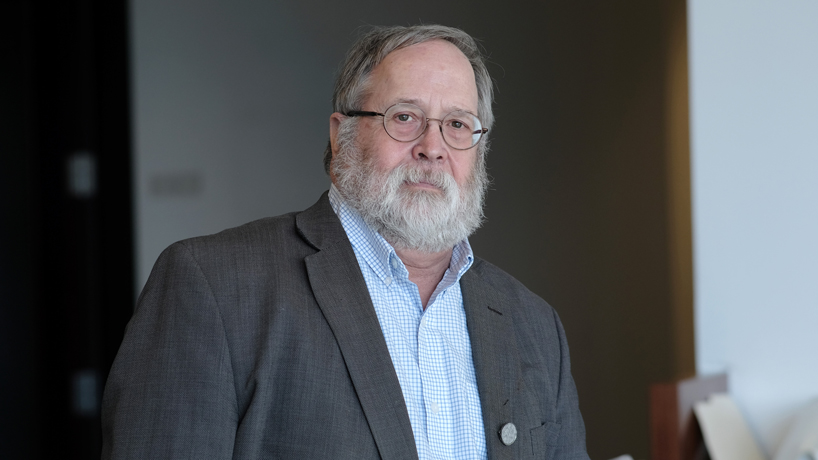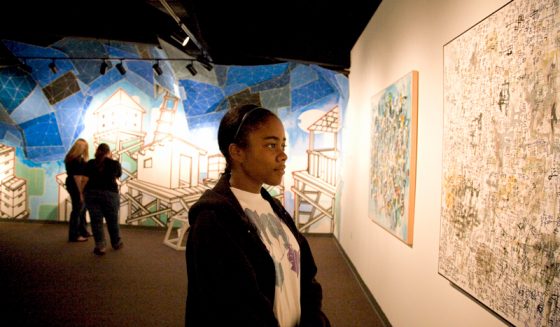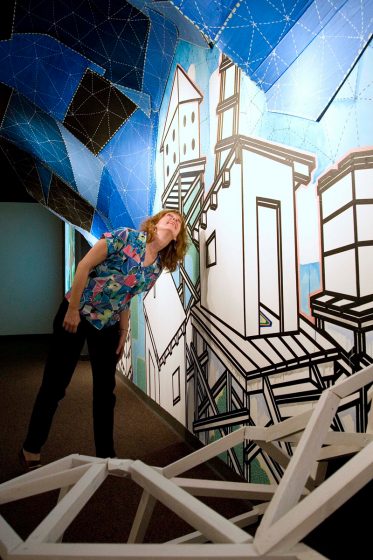
Terry Suhre took over as director of Gallery 210 in 1996 and will retire from the position next month. During his time as director, Suhre exhibited the work of nationally renowned artists and nurtured numerous local artists who have gone onto successful careers. (Photos by August Jennewein)
Ask Terry Suhre to choose a favorite artists or gallery exhibit, and he sounds like a loving parent.
“Well, that’s asking like which of your children do you like best,” he said with good-natured laugh.
Since 1996, Suhre has been the director of Gallery 210 and a research professor at the University of Missouri–St. Louis. His time at the gallery will come to an end April 2 when he retires from the institution he shaped for more than two decades.
But his tenure at the gallery has left an indelible impact on the St. Louis art community and the university.
Over the years, Suhre has exhibited the work of nationally renowned artists such as Chakaia Booker, James Surls, Robert Stackhouse and Carrie Mae Weems and nurtured numerous local artists who have gone onto successful careers.
Additionally, those who have worked closely with Suhre noted he was more than a director or curator. He made Gallery 210 into a regional hotspot for contemporary art, a place where artists engage and comment on the community surrounding them.
“Terry has brought cutting-edge exhibits to Gallery 210 and embraced very difficult, controversial topics in a way that has helped advance the conversation about race and all sorts of social justice issues,” College of Arts and Sciences Dean Andrew Kersten said. “He has used art not simply to curate some of the most important artists in the United States, but he is also using it to help UMSL live its mission, not merely transforming lives but connecting what we do here to a much broader community of people on issues that affect us on a daily basis.”
When Jean Tucker established Gallery 210 in 1971, it was little more than an empty classroom in Lucas Hall. However, Tucker understood the importance of a visual arts space for students. The gallery initially displayed prints and pottery before Tucker started organizing photo exhibitions focusing on modernist lives and landscapes.
The gallery became one of the few venues in the region to focus exclusively on contemporary art, and in the following years, its success and reputation grew. Sylvia Walthers, Tom Patton and Tom Kochheiser ran the gallery after Tucker.
Kochheiser brought some of the most advanced creators in the country to Gallery 210, including feminist artist Hannah Wilke. It was a move that put Wilke on the map and solidified Gallery 210’s place in the contemporary art world.
“I simply tried to continue that work,” Suhre said. “He told the community – he told the country – what Gallery 210 was about. My job was to pick that up and move it forward as much as I could.”
Before coming to UMSL, he was the associate curator for art at the Illinois State Museum in Springfield and then ran the Catherine Smith Gallery at Appalachian State University in Boone, North Carolina. Once he was running Gallery 210, Suhre said his goal was to bring artists to St. Louis whose artwork and philosophy of artwork hadn’t been seen in the region previously. That was how he intended to continue Kochheiser’s work.

Gallery 210 is one of the few venues in the region that is dedicated to showcasing contemporary art, and it has also been a space where artists can confront social justice issues.
Though there were occasionally challenges in living up to that mission. One came in the wake of the Ferguson unrest.
“The social justice themes the gallery picked up were a direct result from Michael Brown being killed in Ferguson,” Suhre said. “My board and friends started holding me accountable for what I was showing. I was showing very respectable and progressive art, but it was somewhat self-indulgent. I really realized that this wasn’t the story that the university should be telling to its own students or to this community.”
As a result, Gallery 210 featured Damon Davis, a multi-media artist and filmmaker who directed the critically acclaimed documentary about Ferguson, “Whose Streets?” Suhre showed Davis’ “Negrophilia,” an exhibition of more than 100 drawings that explored white people’s fixation with the death of Black people.
Maureen Quigley, associate teaching professor and chair of the Department of Art & Design, added that it led to the gallery showing, “Taking It to the Streets,” which showcased the street art that came out of the Ferguson protests. More than giving local activists and artists a space to express themselves, Quigley said it challenged the landscape of the St. Louis art community in confronting the Black Lives Matter movement.
Suhre has exhibited other prominent artists whose work takes on social justice issues and challenges the status quo. The gallery hosted pieces from Basil Kincaid, an artist who interrogates social mores through quilting, collaging and photography, and Jess T. Dugan, who has documented the lives of trans individuals through photographic portraits.
“The university gallery has the latitude to experiment and push artists in directions they don’t always want to go, or maybe they want to go but they don’t have the support from, say, a museum or their own commercial gallery,” Suhre said.
Recently, in addition to social justice, Suhre has taken an interest in design, particularly architecture, though the two often overlap. A recent exhibit called “Urgent Housing” highlighted the work of a number of artists who designed temporary housing units for the unhoused.
Suhre has curated many memorable exhibits over the years, but he still likes working with emerging local artists at the gallery’s annual “Exposure” shows the best.

In recent years, Terry Suhre has taken an interest in design, particularly architecture. A recent exhibit called “Urgent Housing” highlighted the work of a number of artists who designed temporary housing units for the unhoused.
“It’s been this extraordinary incubator for St. Louis artists as they are going out into the world,” Quigley said.
After exhibiting “Negrophilia” at Gallery 210, Davis took it to the Brooklyn Museum, and Kincaid has gone on to exhibit and sell work in Europe. He is also a 2021 recipient of the United States Artists Fellowship.
“St. Louis can hold its own anywhere,” Suhre said. “The artists who are emerging out of here and going national are as good as you’re going to find anywhere and better than most.”
As Suhre’s retirement approaches, the gallery is preparing for the future. It will still continue some of its current programming, but Kersten said the university will look to the community for input on what comes next.
Whatever that might be, Kersten anticipates transitioning to a more community-centered model. Gallery 210 will be a place for artists and creative people to engage with UMSL and help build community.
“What’s becoming clear to me as dean is doubling down on our community engagement is important,” Kersten said. “The communities around UMSL are looking for that kind of leadership and partnership. When we think of Terry, and we think of Gallery 210 and the good work that he did for so many years, the question for us now that Terry is retiring, is how can we take the legacy that he established and bend it toward the forward momentum of the university?”
It’s evident that Gallery 210 will continue to be an important place for local artists and UMSL art students – many of whom will carry on Suhre’s legacy in the region.
“The students here have made it possible for me to do this job,” Suhre said. “I’ve had great crews here and, frankly, most of the time the reason I show up to work is to work with them. It’s always a lot of fun having the students around. They’re really smart. As much as I love the artists, the memories I’m going to take away with me is working with those students. That’s what I’m going to carry with me every day.”














